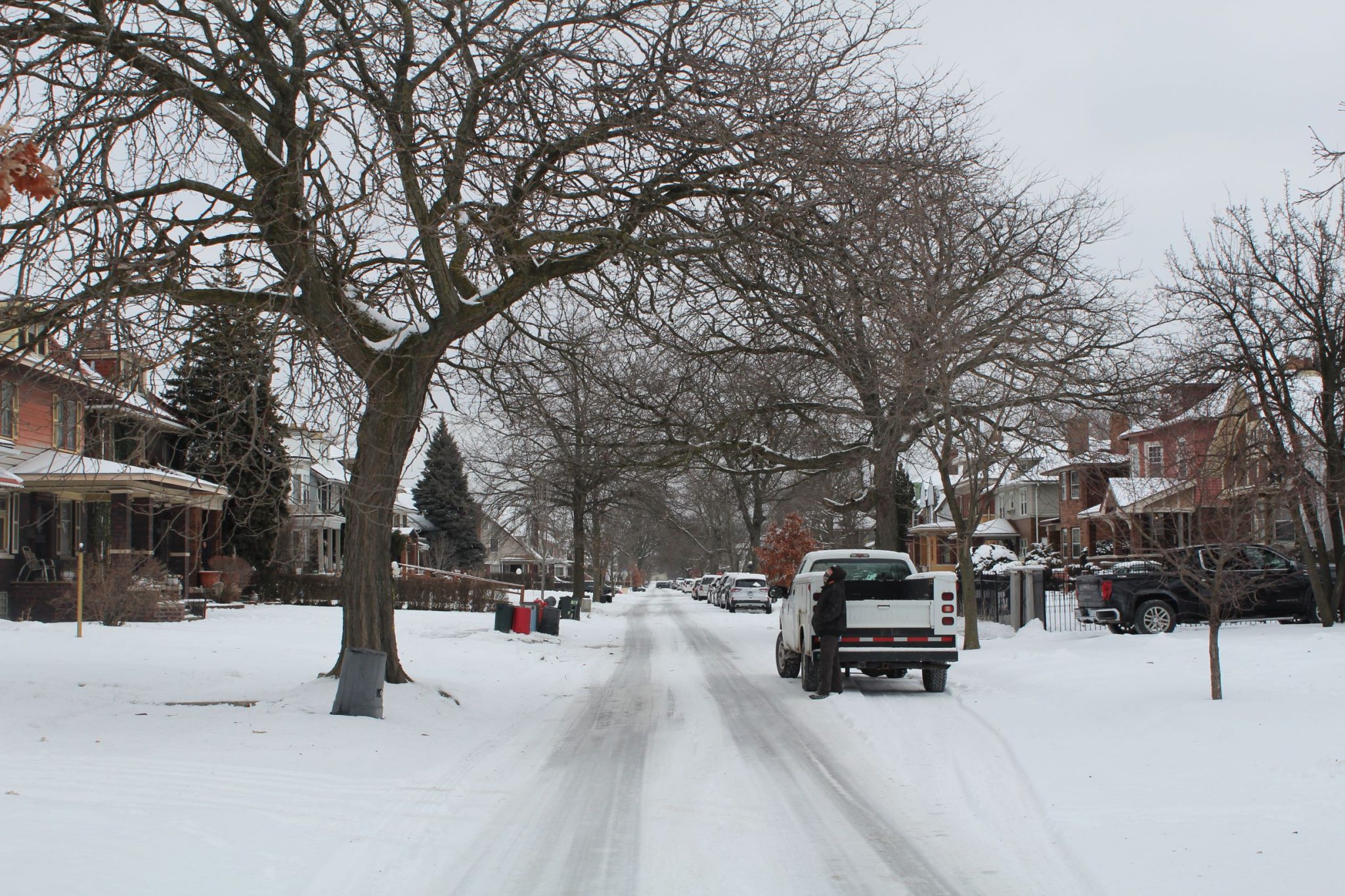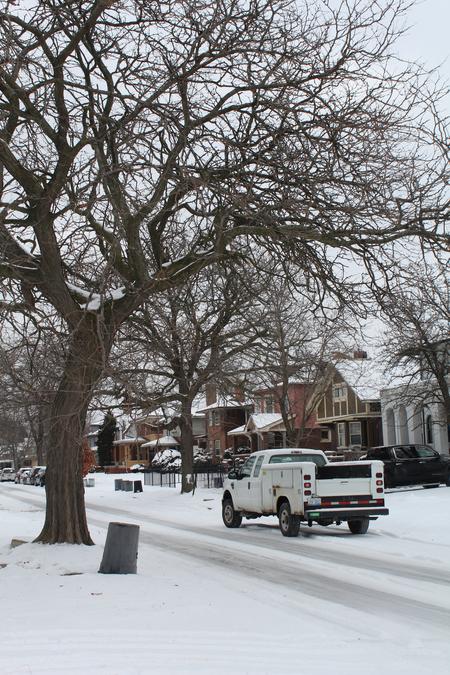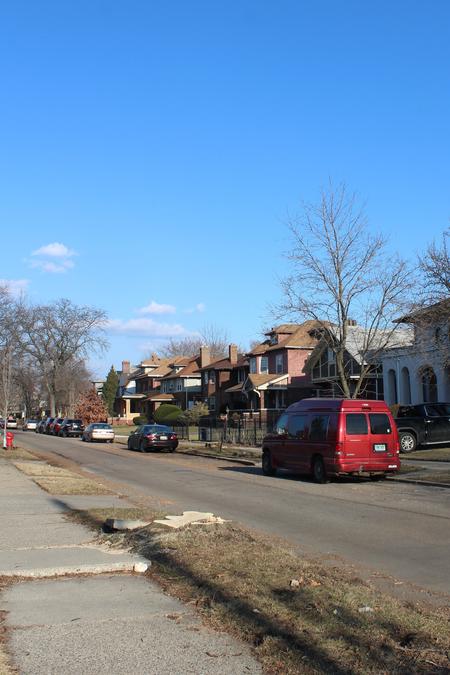Why Highland Park, Once Lined with Elms, Is Cutting Down Trees
The trees slated for removal are diseased, dying, dead, overgrown or had damaged sidewalks, according to the city, but an arborist says the perfectly good ones can be saved.

A tree stands about 30 feet high on a residential street in Highland Park. Its branches span across the street, creating a swathe of shade.
“We have almost just like your stereotypical tree if a kid were to draw a cartoon of a tree,” says Dean Simionescu, a certified arborist. The honey locust he’s standing beside has a big “X” spray-painted on its trunk. The City of Highland Park has slated it to be removed. As part of Simionescu’s job at local tree company Singing Tree, he prunes and removes trees for residential customers. And he doesn’t think this tree should be cut down.
“Why are we even planting trees if we’re going to cut them down when they’re at peak utility for us?” Dean Simionescu, certified arborist
“There’s substantial dead in this but that seems like pruning work. I think that this tree got X’ed because you can see where the sidewalk has gotten bulged up,” says Simionescu, as he uses his foot to scrape the snow off a chunk of the sidewalk raised up about a foot and a half.
Listen: Hear more about the trees that were cut down in Highland Park.
Tree experts say there are techniques that can be used to accommodate a tree when this happens. The concrete can be shaved down, the sidewalk can be moved a few feet to the side or a bridge can be built over the tree roots. Simionescu says some of these techniques could be employed to save this tree. But why should anyone go to all the trouble when it’s much easier to just chop it down?
Simonescu says one reason is temperature control. Trees are integral to cooling down cities, which are known to be much hotter than rural areas. Even within one particular city, research shows areas with trees can be up to 20 degrees cooler. This matters because heat can kill and the death toll from extreme heat is expected to get worse around the globe as the earth’s temperature rises, severely impacting residents in cities like Detroit.
Related Coverage: Power outages in Highland Park and Detroit add to heatwave’s misery | Planet Detroit
“Why are we even planting trees if we’re going to cut them down when they’re at peak utility for us?” says Simionescu.
He says his boss has a new saying about the city in regards to its tree priorities: “‘Maybe we should change the name of Highland Park to the City of Sidewalks instead of the City of Trees?’”
The City of Trees
Highland Park’s motto is the City of Trees because in its heyday it was lined with elms. Most of those trees were wiped out in the 1950s, when Dutch elm disease swept across half the country. Later, the emerald ash borer killed ash trees in Highland Park and the eastern portion of the United States. Currently, oak trees are being threatened by oak wilt in Michigan and other states. The trees lining the streets that survived here haven’t been maintained since 1978.


The City of Highland Park did not grant me permission to do a recorded interview for this story but I was given some information over the phone. According to the city’s Public Works Department, about three years ago, an arborist came out and put together a list of trees that were diseased, dying, dead, overgrown or had damaged sidewalks. The city would not disclose the name or company of the arborist that put together this list, which designated 300 trees to be cut down. Then, in 2020, the city contracted a different company to remove the trees on the list. As residents got wind of what was happening, the city says most were supportive, but a few made requests to keep the trees in front of their houses. The city says it can’t leave a tree just because a resident likes it since Highland Park would have to pay the damages if it fell on a car or house.
Resident Bill McKinney is happy to see large chunks of a tree trunk laying in pieces in front of his house.
“It should have been cut down 20 years ago,” says McKinney. “Because it was dead.”
He grew up in Highland Park and says it’s nice to finally see the city making an effort.
“The city doesn’t have the resources that it should have from the state. The people that stay here in the city are, in large part, low income. So, with it being low income in Highland Park, we receive less services,” he says.
McKinney says he owns multiple houses on the block, including some that he inherited from family, and others that he bought through the Wayne County auction. He says there are vacant lots and abandoned houses on the street that bother him as much as the trees.
“If they can start cutting some of these dead houses down, [that would] be nice too,” says McKinney.
Up the street, the tree that arborist Dean Simionescu said looked like one a kid would draw, is now a shallow stump. Morris Barnes lives just one house over. He says he’s glad that it was removed.
“You can see right there that the tree was taking up the concrete,” Barnes says, pointing to the piece of sidewalk that was dislodged by the roots.
For Barnes, having a well-maintained sidewalk is more important than having a nearby tree. He’s not alone in this sentiment. A study conducted by the Michigan State Department of Forestry found that about 1 in 4 Detroiters did not want a tree when it was offered to them by local nonprofit The Greening of Detroit. Many residents said their decision was influenced by negative experiences with trees that weren’t well-maintained by the city.
Related Coverage: Planting trees in Detroit could save lives, but do people want them?
Simionescu says he can see why some people in Detroit and Highland Park might view trees with a sense of fear.
“Because a tree falling down, if you don’t have insurance, can really, really ruin your life. And because we’ve had poor care of trees and mismanagement, I understand people’s sentiment of, ‘I don’t want a big tree in front of my house.’ But some people do! And if we can support keeping our big trees around and managing them appropriately, well, then by all means we should do it because it’s important for our community,” says Simionescu.
Highland Park is working on getting a grant with The Greening of Detroit to replace all of the trees that have been cut down. Still, it will be decades before the new trees reach the height and span of the ones that were removed. Plus, the city says it expects many of the residents who had trees taken down aren’t going to want them replaced.
Trusted, accurate, up-to-date
WDET is here to keep you informed on essential information, news and resources related to COVID-19.
This is a stressful, insecure time for many. So it’s more important than ever for you, our listeners and readers, who are able to donate to keep supporting WDET’s mission. Please make a gift today.
